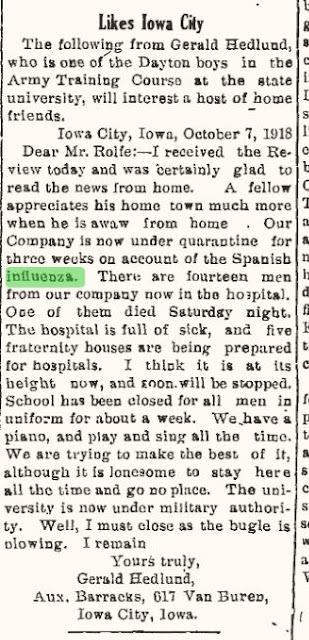We have been dealing with the world-wide COVID for two years now, most of us vaccinated, some of us contracting the disease, and to my knowledge, no family members having died from the disease. We have heard from time to time the comparisons of COVID to the 1918-1919 Influenza that was also worldwide and deadly.
I don’t wish to discuss our situation today because I know how emotional, and political, it has become. But I’d like to write today’s post about what I’ve learned about the Influenza and its effect on our Iowa family members.
The Influenza actually had nothing to do with Spain. The best guess is that it started in Haskell County, Kansas, where the first known case was recorded. A remote farm area, it might seem unlikely for it to have traveled so quickly and become a worldwide pandemic. But, when we take into account our involvement in World War I, one can see how this could happen.
From Haskell County and other parts of Kansas, men came into close contact with each other at Camp Funston (now known as Fort Riley). Over 500 soldiers became ill there in the first week of March 1918, and within 3 more weeks, more than 1,100 men were sick. And by the end of the spring, 48 soldiers had died.
Still, after training, soldiers were dispersed to other camps, other bases, and then onto ships to Europe. Once the virus reached Europe, it spread quickly, not just among Americans, but also among our Allies.
Ships now traveling back and forth to and from the United States carried the original strain as well as new, more dangerous ones. And now we see an unchecked spread in the United States, especially in large cities like New York, Chicago, Boston, San Francisco. Strains continued to mutate. The flu reached more remote areas, and eventually it killed 16 million people worldwide. The war itself had killed about 50 million people. Thirty percent of our army was affected.
My great Uncle Frank Linn, a soldier in France, was detained and quarantined before he was allowed to board the ship back to the United States. Undoubtedly, it was the flu.
When we review death records for 1918 and 1919, it’s important to look at “hidden” or “alternate” causes of death. Some were listed as having died of spinal meningitis or pneumonia when it was really Influenza.
What influence did this have on daily life in the United States? Theaters, churches, bars, and other public places were closed because of the flu. Schools in Chicago were closed for a time. During this time, the life expectancy in the United States dropped by 12 years. In Iowa, schools were closed, masks were mandated, and many businesses had to close temporarily or even permanently. Farmers were able to feed themselves and their families, but I wonder how well they were able to move food or animals to their next destinations.
Below is just a sampling of articles taken from the Dayton and Stratford areas. Included are two links to more details about the origin of the flu and the protests about wearing masks.
Most of the information from these articles reminds me a great deal of what we are now going through. Pandemics 100 years apart. Affecting our ancestors then and us today.
Dayton Review, October 1918








No comments:
Post a Comment